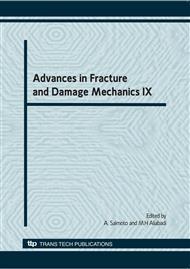[1]
B.D. Bogy: Journal of Applied Mechanics (1971), pp.911-918.
Google Scholar
[2]
D.N. Fenner: International Journal of Fracture, Vol. 12, No. 5 (1976), pp.705-721.
Google Scholar
[3]
P. Hutař, L. Náhlík and Z. Knésl: Computational Materials Science 45 (2009), pp.653-657.
DOI: 10.1016/j.commatsci.2008.08.009
Google Scholar
[4]
P. Hutař, L. Náhlík and Z. Knésl: Key Engineering Materials Vols. 385-387 (2008), pp.317-320.
DOI: 10.4028/www.scientific.net/kem.385-387.317
Google Scholar
[5]
J. Klusák and Z. Knésl: Computational Materials Science 39 (2007), pp.214-218.
Google Scholar
[6]
K.Y. Lin and J.W. Mar: International Journal of Fracture, Vol. 12, No. 4 (1976), pp.521-531.
Google Scholar
[7]
L. Náhlík, L. Šestáková and P. Hutař: Computational Materials Science 46 (2009), pp.614-620.
DOI: 10.1016/j.commatsci.2009.04.005
Google Scholar
[8]
L. Náhlík, L. Šestáková and P. Hutař: Materials Science Forum, Vols. 567-568 (2008), p.225228.
Google Scholar
[9]
K.H. Oh and K.S. Han: Composites Science and Technology 67 (2007), pp.1719-1726.
Google Scholar
[10]
C.L. Hsieh and W.H. Tuan: Materials Science and Engineering A 393 (2005), pp.133-139.
Google Scholar
[11]
B.N. Kim: Engineering Fracture Mechanics Vol. 59, No. 3 (1998), pp.289-303.
Google Scholar
[12]
W. Wang, K. Sadeghipour and G. Baran: Composites: Part A 39 (2008), pp.956-964.
Google Scholar
[13]
P. Hutař, Z. Majer, L. Náhlík, L. Shestakova and Z. Knésl: Mechanics of Composite Materials Vol. 45, No. 3 (2009), pp.281-286.
Google Scholar
[14]
H. Shen and C.J. Lissenden: Materials Science and Engineering A 338 (2002), pp.271-281.
Google Scholar
[15]
N. Chawla, R.S. Sidhu and V.V. Ganesh: Acta Materialia 54 (2006), pp.1541-1548.
Google Scholar
[16]
K. S. Ravichandran: Acta Metallurgica Materialia Vol. 42, No. 4 (1994), pp.1113-1123.
Google Scholar
[17]
R.A. Schultz: Journal of Geophysical Research, Planets 98(E6) (1993), pp.10883-10895.
Google Scholar
[18]
S.S. Smith, P. Magnusen and B.J. Pletka, in: Fracture Mechanics Methods for Ceramics, Rocks and Concrete, ASTM STP 745, edited by W. Freiman and E.R. Fuller, American Society for Testing and Materials (1981), pp.33-45.
DOI: 10.1520/stp28296s
Google Scholar
[19]
Z. Knésl, L. Náhlík and Z. Keršner: Structural Engineering, Mechanics and Computation, edited by A. Zingoni, Elsevier Ltd. (2001), pp.737-744.
Google Scholar
[20]
Database of material properties on http: /www. matweb. com.
Google Scholar


